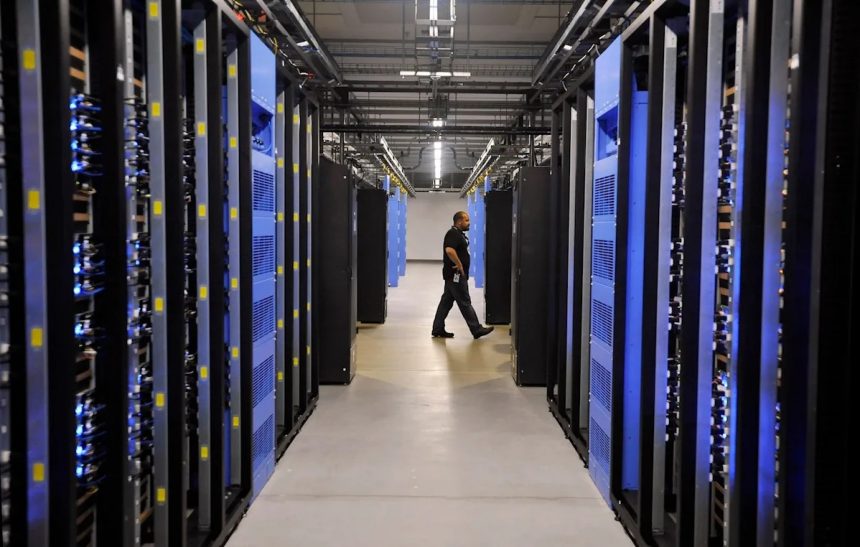In small communities across North Carolina, data centers are already sparking conflict over land use, water use, and quality of life. Now, the debate over the facilities’ voracious need for electricity — and whether it can be met with clean sources — is heating up in the state capital of Raleigh.
For months, North Carolina’s predominant utility, Duke Energy, has forecast ballooning demand from large customers like data centers: immense buildings that house the computing devices powering AI and other software that’s become part of everyday life.
Early last year, Duke projected these “large loads” would need an additional 3.9 gigawatts of capacity, equal to about four nuclear power plants and enough to serve millions of households. By May of this year, the company’s prediction had swelled to almost 6 gigawatts.
The eye-popping estimates helped lead regulators to approve Duke’s current plan to build a massive new fleet of gas plants, alongside some clean energy investments, despite a state law requiring the utility to decarbonize. The projections are certain to factor into the next iteration of Duke’s long-term blueprint, a draft of which is due in the coming weeks.
The forecasts have “thrown everything out of whack,” said Nick Jimenez, senior attorney with the Southern Environmental Law Center.
That’s why his organization asked the state’s Utilities Commission to host a technical conference on large loads. Electricity-demand projections undergird virtually every Duke case before the panel. But at a technical conference, commissioners could grapple exclusively with the issues vexing energy experts across the country: How can data center demand be predicted with the most accuracy? Will the tech giants pay their fair share of grid upgrades and other costs? What will power the new facilities, and will it be carbon-free?
In June, the Utilities Commission granted the law center’s request and then some by opening an entire proceeding to debate these questions. Stakeholders had the summer to submit written comments, with responses due from Duke early this month. In-person presentations are scheduled for Oct. 14.
It’s not clear if the process will culminate in a discrete order from the commission, or simply inform the myriad other Duke cases before it. But Jimenez praised regulators for being proactive. “You need a proceeding to get your arms around some of these issues,” he said. “I think that’s really smart and forward-looking.”
The data center boom
In the race against other states to attract economic development, Duke and North Carolina officials keep confidential exactly which entities hope to draw power from the electric grid. And skeptics question whether all of the new facilities behind predictions of unprecedented demand growth will pan out.
But there’s little doubt that data centers are on the rise, propelled by the AI explosion. Researchers say they could account for 44% of U.S. load growth by 2028, and there’s ample evidence that North Carolina is following the national trend.
In June, Amazon Web Services announced a $10 billion, 800-acre computing campus in Richmond County, east of Charlotte, billed as the largest single capital project in North Carolina history. To the west of Charlotte, the development of a “data center corridor” is underway: Apple says its Catawba County site is included in its $500 billion U.S. expansion plans, and Microsoft envisions four new data centers nearby. Google is considering growing its facility in neighboring Caldwell County.
Not all communities are welcoming data centers with open arms. The town council of tiny Tarboro, an hour east of Raleigh, just voted to reject a $6.4 billion facility. In Apex, southwest of the city, opposition is mounting to a proposed “digital campus” that would displace 190 acres of farmland.
Still, early this month, Gov. Josh Stein, a Democrat and former attorney general, issued an executive order creating an “AI Accelerator” and a council designed to make the state “a national leader in AI literacy, governance, and deployment to the benefit of our residents, communities, and economy.”
Stein did note the technology’s downsides, including “the uncertainty around AI systems and their associated energy and water needs.” But his edict also reflects the seeming common wisdom of the moment: AI and its requisite facilities are multiplying and expanding, bringing economic opportunities that can outweigh their challenges.
“We can come to the table”
In the open docket before regulators, experts say that with the right policies in place, clean energy, efficiency, and related strategies can meet the moment. “We can come to the table,” said John Burns, general counsel for Carolinas Clean Energy Business Association, a trade group representing developers, manufacturers, and others in the clean energy industry.
In their comments, Burns and others particularly promoted “load flexibility,” a form of demand response in which data centers curtail their electricity use when the grid is strained by lots of energy consumption.
Load flexibility is feasible because data centers don’t run at maximum capacity 24/7, said Tyler Norris, former special adviser at the U.S. Department of Energy and a doctoral fellow at Duke University, which has no connection to the utility.
“You never actually run the chips and the servers to 100% of their rated nameplate power,” he said. “You wouldn’t want to, because they overheat and they don’t perform as well when they’re running that hard.”
Norris is the lead author of a February paper showing that Duke’s two utilities in the Carolinas could accommodate 4.1 gigawatts of load if data centers shave just 0.5% off their peak usage annually. In a simple example, the facilities could operate at half their maximum capacity for 88 hours over the course of a year.
A load-flexibility arrangement between Duke Energy and data centers could, in theory, avert the construction of several gigawatts of new gas plant capacity and expensive and time-consuming transmission upgrades.
Last month, Google announced demand-response agreements with the utilities Indiana Michigan Power and the Tennessee Valley Authority. In formal comments to the North Carolina Utilities Commission, Norris called the tech giant’s move the “first documented case where AI data center flexibility is explicitly integrated into U.S. utility planning.”
That’s why he hopes North Carolina regulators will study other means of incorporating curtailment, perhaps starting with voluntary measures, into Duke’s long-term plans.
“I think we need more creative thinking, and dialogue, and analysis around this kind of flexibility opportunity,” Norris told Canary Media. “It just has such substantial implications for affordability and reliability.”
Clean, cheap, quick
Even if Norris’ calculations bear out, Duke Energy’s projections show it will need hundreds more megawatts of power capacity in the next decade for large loads alone. And for AI data centers, the quicker the better: In Virginia, the world’s data center capital, construction of the facilities takes 18 months or less.
That’s where utility-scale solar and storage could be especially useful, said Burns. “Not only are the resources of our members clean,” he added, “they’re also less expensive and quicker to market.”
A June report from global investment firm Lazard concludes that land-based wind turbines and large solar farms “remain the most cost-effective forms of new-build energy generation on an unsubsidized basis.”
By contrast, Lazard says, “the cost of building a new combined cycle gas turbine has reached a 10-year high. Turbine shortages, rising costs, and long delivery times are expected to continue driving steep [levelized cost of energy] increases for gas technologies in the near term.”
The North Carolina Department of Commerce has adopted Gov. Stein’s “all-of-the-above energy deployment approach,” said Jennifer Mundt, the agency’s assistant secretary for energy and infrastructure. But renewables align with the department’s economic development mission because nearly half of all Fortune 500 companies aim to reach net-zero emissions by 2050, Mundt wrote in her letter to utility commissioners. “Companies are prioritizing sites with access to diverse energy sources,” she noted, as well as those with affordable, reliable electricity.
Especially after the legislature repealed a key target for emissions reductions this summer, many tech giants now have more aggressive clean energy goals than the state. Amazon has pledged net-zero carbon emissions across its global operations by 2040. Google aims to power its data centers with 24/7 carbon-free energy by 2030.
“Google leadership remains firmly committed to this goal,” the company said in its comments to regulators, “making it critical that we are able to identify viable pathways to supporting new carbon-free energy resources as we continue to grow our business.”
A best-case scenario for the clean energy transition?
In their comments to regulators, experts highlight a range of policies that would help data center growth align with — rather than contravene — the clean energy transition.
A voluntary “clean transition tariff,” for instance, would allow data centers to pay for new renewables to come online, rather than just chip in for carbon-free energy already in the works. In Nevada, Google partnered with utility NV Energy on such a scheme, which will enable 115 megawatts of around-the-clock geothermal power to supply the company’s data centers.
North Carolina regulators could consider inducements for so-called “energy parks,” where data centers and other large loads would be clustered around their new energy sources, reducing interconnection delays and the need for transmission upgrades. The on-site energy generation could increase the resilience of the grid as a whole, serving as backup power for the utility.
Indeed, “virtual” or “distributed” power plants, whereby utilities can access non-centralized energy resources during times of need, could help avoid the construction of new power plants, saving utilities and their customers billions of dollars.
The practice is already being tested elsewhere in the U.S. Black Hills Energy negotiated a contract with Microsoft that allows the utility to tap backup generation at the tech company’s Cheyenne, Wyoming, data center during periods of high electricity demand.
For Jimenez of the Southern Environmental Law Center, the best-case scenario is that the regulators adopt these and other policies suggested by advocates, such that “the large load that comes to the state pays for its own clean generation, and the rest of us don’t pay excessive bills.”
The worst-case scenario, he said, “would be to do nothing.”
Of course, doing nothing is a distinct possibility. Like all investor-owned, monopoly utilities, Duke is financially motivated to invest in as many capital assets as possible, to be paid back with interest by captive customers. Though it was overridden, the utility opposed the Southern Environmental Law Center’s original request for a technical conference.
In September comments to the commission, Duke said there is “no need to rush into major changes” or “any paradigm shift.” It pointedly argued against reforms that might take place outside a general rate case or the long-term planning process. It acknowledged the risk of building new power plants that may not be used fully by large loads, but asserted that existing regulatory processes and other factors assure that in the short-term, “there is more than ample protection against investment in generation assets that are not needed.”
What’s more, it bodes ill that last year’s much-vaunted agreement between Duke and data center giants to develop a clean transition tariff in the Carolinas appears to have fizzled: Despite promises otherwise, the utility has yet to request such a tariff.
But Duke’s September comments did offer a few rays of hope for advocates. Load flexibility, it suggested, is no panacea, but the company acknowledged that “well-structured flexible operations can provide benefits for customers.”
On virtual power plants, the company said it is “open to all ideas that could provide benefits to the system as a whole and are compliant with applicable law. … Creative engagement around such ideas is essential.”
Meanwhile, the commission’s perspective may be in flux. Unlike the panel that opened the docket in June, a majority of the body’s members are now appointed by Republicans, and it has elected a new chair. How regulators engage in this debate will become clearer when experts gather in October.









